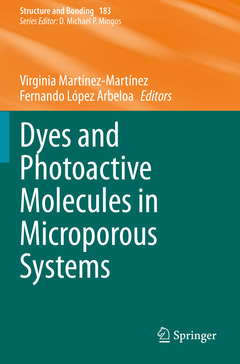Description
Dyes and Photoactive Molecules in Microporous Systems, 1st ed. 2020
Structure and Bonding Series, Vol. 183
Coordinators: Martínez-Martínez Virginia, López Arbeloa Fernando
Language: English
Subjects for Dyes and Photoactive Molecules in Microporous Systems:
Publication date: 12-2021
406 p. · 15.5x23.5 cm · Paperback
Publication date: 12-2020
406 p. · 15.5x23.5 cm · Hardback
Description
/li>Contents
/li>Biography
/li>Comment
/li>
This book provides an overview of the design, synthesis, and characterization of different photoactive hybrid organic-inorganic materials, based on the combination of mainly organic molecules and inorganic nanostructures, tackling their uses in different scientific fields from photonics to biomedicine.
There are many examples extensively describing how the confinement of organic compounds (i.e. chromophores, photochromic molecules or photoreactants), or other photoactive compounds (i.e.metal clusters) into several microporous systems can modulate the photophysical properties and photochemical reactions leading to interesting applications. Among (ordered)-hosts, different systems of diverse nature are widely used, such as the, the 1D- or 3D- channels of zeolitic frameworks, interlayer space of 2D-clays, the organic nanospace of curcubituril and cyclodextrins or the organo-inorganic porous crystalline MOFs systems.
This volume highlights the advances of these photoactive materials and aims to be an inspiration for researchers working in materials science and photochemistry, including chemists, material engineers, physicists, biologists, and medical researchers.
Dr. Virginia Martínez-Martínez graduated in Chemistry in 2001 (Extraordinary Prize of Degree). She obtained her PhD at the University of the Basque Country (UPV/EHU) in 2005 (Extraordinary Doctorate Award) under the supervision of Prof. Dr. Fernando and Iñigo López Arbeloa. Her doctoral thesis was focused on the development and characterization of oriented hybrid dye/clay films. She did a postdoctoral stay for 2 years (2006-2008) at KU Leuven (Belgium), under the supervision of Prof. Dr. Johan Hofkens, acquiring knowledge on fluorescence microscopy at single molecule level, applied to study (bio)catalytic events in real time. She returned to the Physical Chemistry Department at the University of the Basque Country and after the Ramon y Cajal contract (2012-2017), she became Tenured Permanent Researcher. Virginia does research in Materials Chemistry and Spectroscopy. Her groups current scientific projects are: 1.Photoactive hybrid materials, based on the combination of fluorescent dyes into inorganic and organic systems such as 2D-clays, MOFs or porous zeolitic systems, for optical applications; 2. Multifunctional dyes based on BODIPY chromophore, mainly dedicated to the development of new photosensitizers and improved fluorescent probes for bioimaging; and 3.Nanoparticles as drug carries for their implantation in photodynamic therapy and teragnosis.
Prof. Fernando López Arbeloa obtained the PhD Degree in Science at the Katholieke Universiteit Leuven (KUL, Belgium) under the supervision of Prof. Dr. F.C: De Schryver in 1987. He became Full Professor at the University of the Basque Country (UPV/EHU, Spain) in 2002. He teaches Quantum Chemistry and Spectroscopy in the Department of Physical Chemistry. His research fields include the photophysical characterization of fluorescence dyes both in homogeneous liquid media and polymeric matrices, and in nanostructured inorganic solids with interest in photonics applications and se
Presents an overview of new photoactive systems in constrained media: structures, properties and applications
Offers a detailed description of functional materials based on a combination of photoactive compounds and nanostructured organic / inorganic matrices
Highlights the importance of confinement effects to control the tunable optical properties of the resultant photoactive materials




